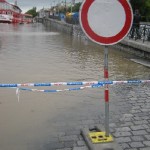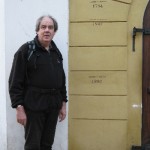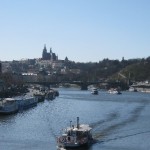
On Mondays (my day off), and sometimes on Saturdays if I get the sermon finished in time, Sybille and I like to walk and explore different parts of Prague. Here are two pairs of pictures taken during two walking forays into different parts of the city during February 2011.
These first two pictures were taken in Troja, a suburb located on the other side of the Vltava from where we live and close to Prague Zoo. They show newly constructed flood defences, designed to protect the neighbouring housing and also the nearby zoo, from future flooding should the Vltava rise to levels similar to those experienced in the catastrophic floods of August 2002. These defences are quite new – when we were last here a few months earlier, major construction works were still underway.
The gap in the high concrete wall, allows road access to the riverside during times of normal river levels. But should water levels rise rapidly, then a sunken metal barrier can be raised between the two sections of the wall, blocking the road, but preventing floodwater from going any further.

The second picture shows the view alongside the river, at right angles to the first picture. The concrete wall with pillars on the left, is the continuation of the concrete wall in the first photograph. Again, there are sunken metal barriers between the pillars which can be raised in time of serious flooding. But when river levels are normal, the barriers are left down, allowing more light into the car park immediately behind the wall and the into the houses beyond.

The second pair of photographs were taken in the suburb of Hanspaulka, a little further west from where we live. The housing in Hanspaulka mainly dates from the first four decades of the twentieth century. However, the suburb also contains a number of examples of blocks of flats built in the early years of the Communist era, to provide much needed additional housing for the growing population of post-war Czechoslovakia.
Much grandiose Communist era artwork on buildings in the Czech Republic has quietly been eliminated and destroyed. But this somewhat quaint piece above the doorway of a small-scale three or four storey block of flats, has survived. As it says, it dates from 1951, only three years after the Communist coup of 1948. It celebrates two archetypal labourers working in heavy industry, ironically located in a suburb where such heavy industry has never existed!

The second photograph puts the artwork in context, showing where it is located, above the entrance to the flats built to house the hardworking proletariat. It also shows another feature found on many buildings across Prague – the provision of metalwork, located immediately below the street number of the building, to allow the display of two flags. As I explained in an earlier post about public holidays in the Czech Republic, in the Communist era this was for the display of a flag of Czechoslovakia, alongside the flag of the country’s fraternal friend, the Soviet Union. These days, two Czech flags will be displayed!




They should put up a double dose of Czech flags. Whenever there are two Czech flags displayed on the front of trams it looks so festive.
I LOVE to see Communist Art. I think the Czechs are going to wish they haven’t taken so much of it down. First of all, tourists go nuts for it. Secondly, while they are sick of it, the Czechs should think of future generations. This is one part of their continuing story. The artwork is a reminder, and in this case a beautiful reminder, of what they survived and lived through. It’s as much a part of Prague as Old Town’s cobblestone streets.
Hi Karen,
This is always a difficult call. You can fully understand why the Czechs got rid of the massive statue of Stalin on Letna, even before the fall of Communism in 1989. But other examples of Communist artwork & architecture do survive. We live close to what is now the Crowne Plaza Hotel which is a wonderful example of Stalinist Baroque architecture based on the design of Moscow University. You can see it in the background of my photo in this post http://rickyyates.com/holidays-and-celebrations-in-the-czech-republic-%E2%80%93-my-contribution-to-expats-world-blog-surf-day/ which also illustrates double flagging on trams.
Zlin (formerly Gottwaldov) has a lot of very nice Comunist-era house art (above the doors of the rows of Svit /a shoe factory, formerly Bata Shoe factory/ worker housing). Like many towns (Bratislava and Warsaw spring to mind, but the top of Wecneslas Square was chopped off the same way in front of the for Parliament Building /then used by Radio Free Europe and now the ‘New’ Building of the National Museum/ and the National Musuem), the Soviet planners ran the main road through the historical centre and destroyed most of its charm. The nice park between the rail station and the city hall is actually an old cemetery and bones appear with each years’ new erosion. If you get further away from the town centre though, you get into those older neighbourhoods that are very nice to see.
In Pilsen, they put up US and Czech flags for the May bank holiday for the end of the War (8 May now, previously 9 May). It is quite an interesting sight:-) They also have a ‘Thanks, America’ Statue on Americka Street, a memorial to the 3rd Infantry at Chodske namesti, Patton Bridge and of course Sady Petatricatniku (‘Gardens of the 35th’ /sadly all concrete today/ for the Belgian liberators).
I also find the double Czech flags on trams etc. to be festive. Imagine how dull a Czech flag sticker would look in its place. Sometimes traditions are best left alone to be savoured for their unique nature.
Your hotel that is currently Crowne Plaza is indeed interesting. To get all the generals standing on a stair when Stalin arrived a stair had to be added after it was built. – It is the main staircase in front of you as you enter. I taught at the Institute of Tourism and Management there for several years back in the 1990s. The stories of that hotel could take weeks to recount.
I agree about Stalin, he had to go. That space is waiting for something special. Have they put something else up yet? My idea is it needs to be something that brands Prague as the romantic city that it is. Why should Paris get all the traffic?
These days there’s something charmingly old fashion about Communist artwork. As the world (hopefully) moves on to forms of government that treat’s its citizens better I hope something is done to preserve these little pockets of such artwork that still exist in places like Czech.
It is funny how things that once were symbols of..I don’t want to say oppression..”difficult times”, can quickly be transformed into romanticized pieces of history. The art work is wonderful, but I don’t think Stalin would have ever made the “quaint” category.